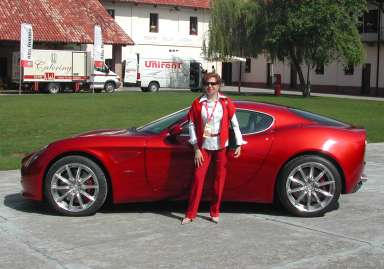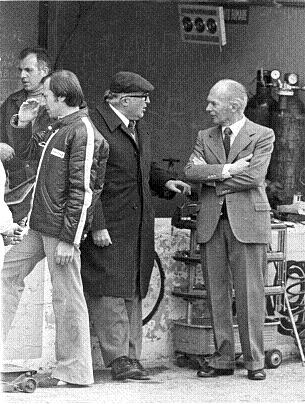
|
The History of Alfa Romeo
(by Elvira Ruocco)
Article 5
|
DICA: 33! *
The racing “33”s
In 1964, twelve years after the withdrawal from Formula 1 and
after Ferrari and Porsche had decided to produce racing cars for
the category Sport Prototypes up to two litres of capacity, the
Alfa Romeo management planned to return to international sport
competitions with the “33” models.
The financial situation of Alfa Romeo had been sensibly improved
and, thus, after the parenthesis of the numerous victories with
the production cars, time had come to run with cars built on
purpose for the international competitions. Furthermore, it always
had been a policy of the Milanese house, to exploit as much as
possible its sports programmes in order to profit from a technical
viewpoint and, at the same time, to promote from a commercial
viewpoint its industrial plans.
The 33/2 name comes out of the internal code from the Design
Offices of the Portello, where the project of this new car was
denoted by type AR 105.33 code: the 2 after the slash was added to
denote the cubic capacity thereof. It was chosen an 8C engine with
a 90-degree V, with a displacement of 1.995 cubic centimetres, 4
overhead camshafts, indirect fuel injection, monodisk dry clutch,
6 ahead plus one reverse speed gearbox, self-blocking differential,
with a 310 CV SAE power at 9.600 revs/minute. This same engine was
then successively mounted on the 33 Stradale and on the Montreal.
The chassis, absolutely atypical and revolutionary, was inspired
by the aeronautical engineering and was considered by everybody a
technological masterpiece. The tuning of the chassis and of the
mechanical parts was not laborious at all, but we cannot say the
same as far as the definition of the body is concerned, which
showed some initial difficulties of aerodynamic nature and of
stability because of the geometry of the suspensions, drawback
that was brilliantly worked out.
The prototype was implemented in a little more than one year by
the Portello engineers under the guidance of Orazio Satta and
Giuseppe Busso, and made its first test coming out on the Balocco
track in the month of January 1966, equipped with a provisional
TZ2 engine.
Giuseppe Busso with Carlo Chiti
 As Busso embittered remembers, in his book of memoirs “In the
heart of Alfa”, the prototype was committed to Autodelta’s eng.
Chiti in order to undergo a further experimental development phase.
A picture in front of the track entrance with Busso beside the car,
Sanesi at the steering wheel and Chiti casting glances through the
glasses, witnesses the “hand over of offices”.
As Busso embittered remembers, in his book of memoirs “In the
heart of Alfa”, the prototype was committed to Autodelta’s eng.
Chiti in order to undergo a further experimental development phase.
A picture in front of the track entrance with Busso beside the car,
Sanesi at the steering wheel and Chiti casting glances through the
glasses, witnesses the “hand over of offices”.
The first spider version, called “periscopic” owing to the air
intake positioned in the upper part of the body, was presented to
the press exactly on the Balocco track on March 6, 1967. The next
year, with a coupe bodywork, took part to the “Daytona
Continental”, one of the world longest car races, only rival of
the 24 Hours of Le Mans. The three competitor models headed the
finish line united, ranking at the first three places. From that
event, it was renamed “33 Daytona”. Still in 1968, it gained
15 absolute and 6 class victories, some of which memorable as the
ones reached on the Mugello, Imola and Vallelunga circuits. In
1969, with 14 absolute and 13 class victories, confirmed itself as
the best European car in the Sport Prototypes 2000 class, making
its rivals Ferrari and Porsche disappear from the competition
scene. At the end of the season, Alfa gave to privateers the cars,
which continued to win in the next year, and abandoned in this way
the 2-litre category.
On the chassis and mechanics of the 33/2, designers like
Pininfarina, Scaglione , Bertone and Giugiaro carried out the
gorgeous “dream cars” that can be admired in the Historical
Museum of Arese.
A red 33 Stradale was a movie star too, leading character together
with Gina Lollobrigida in the Mauro Bolognini’s film:
A
wonderful November.
In the Historic Archive photographic albums, there is also a nice
picture of the the then Princess Paula of Liège at the wheel of a
33/2 on the Balocco track.
During 1968, it was finished the design of the 33/3 which adopted
a spider fibreglass body on a monocoque chassis with aluminium and
titanium stress bearing panels. The engine was an 8C with a
90-degree V and a displacement of 2.998 cubic centimetres, with 4
valves per cylinder, electronic ignition and a power of 400 CV at
9000 rev/min. The frame, made out of a box section avional sheet,
was different from the one of the 2 litres. Its debut occurrend in
1969 and gained two absolute victories in Zeltweg and at the City
of Enna Cup (in Sicily, note of translator). Meanwhile the
realization of a new version with an aluminium-alloy tube
spaceframe was going on: the 33/TT3 which, in 1972, ranked at the
second place in the Word Championship for Makes.
In 1975, a new version made its debut: the 33 TT12 with fibreglass
body and a 12-cylinder 2.995-cc boxer engine which developed a
power of 500 CV DIN at 11.000 revs/min. With this car, Alfa Romeo
won, with the victory in seven out of the eight races in the
calendar, the world title by showing an absolute technical
superiority. Two years later, the last version of the 33s was
introduced: the SC12, with fibreglass body on a box section
aluminium frame, which, by winning all the eight races which made
up the championship, won the World Sportscars Championship 1977.
Elvira Ruocco
(*) translator's note: "Dica 33" is the Italian
equivalent for the "Say 99" phrase physicians use to
auscultate patient lungs.
Copyright Information and Credits
All the multimedia materials and the texts present in this page cannot be reproduced in any way
without the explicit permit of authors and/or owners of the contents. In particular, this applies
with reference to texts and pictures of Ms. Elvira Ruocco
and of the Alfa Romeo Historic Archive
who explicitly authorized the AlfaSport Club for publication.
|

